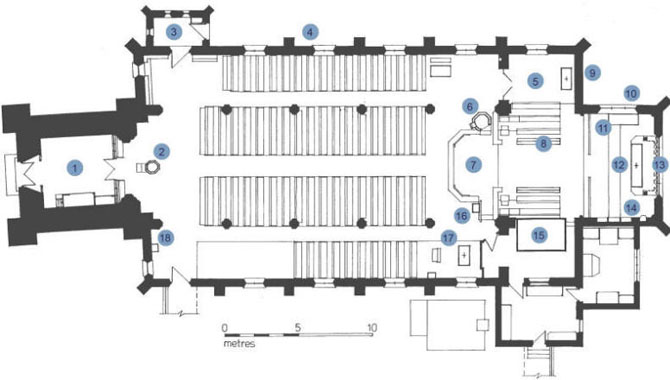
Here’s our church. You can read more about it here and see some photos. Better still, come and visit us. The church is usually open between 9.30am-4.00pm.
With the help of our Rickmansworth Decorative Fine Arts Society, we’ve put together a Church Trail for our younger visitors – and our older ones too!
This will guide visitors round the church, looking at the architecture, history and furnishings. It encourages visitors to explore our beautiful church, to learn about it and, we hope, inspire them to visit other churches too.
If you are planning to visit St Mary’s, particularly with young people, you can download the questionnaire and accompanying answer sheet before your visit. Copies are also available at the back of the church.
 The tower dates from 1630. It is faced with knapped flints and dressed with stone but built internally of brick.
The tower dates from 1630. It is faced with knapped flints and dressed with stone but built internally of brick.
The spirelet is a typical Hertfordshire ‘spike’ and is probably as old as the tower.
The chiming clock on the north face dates from 1904.
The tower houses a ring of ten bells.
 The font was placed at the west end of the church during the rebuilding of 1890 to act as a symbol of baptism as the means of entry into the Church as the family of Christ.
The font was placed at the west end of the church during the rebuilding of 1890 to act as a symbol of baptism as the means of entry into the Church as the family of Christ.
The present font was given in memory of Lieutenant Alfred Northey who was killed in action on 12th October 1914.
The carved font cover was presented by the Revd H Shepherd in 1945.
 The St Christopher window was given in 1946 in thanksgiving for the ending of the 1939-45 war.
The St Christopher window was given in 1946 in thanksgiving for the ending of the 1939-45 war.
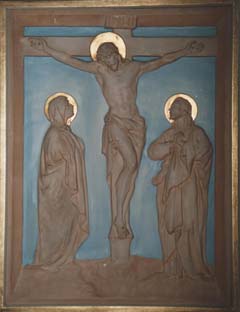 Starting by the Lady Chapel and following round the church to the Resurrection Altar, this series of bas-relief panels depicts events following the arrest of Jesus until his being laid in the tomb.
Starting by the Lady Chapel and following round the church to the Resurrection Altar, this series of bas-relief panels depicts events following the arrest of Jesus until his being laid in the tomb.
They were made by Sisters of the Church and given anonymously following the ending of the 1939-45 war.
These pictures are used as subjects for meditation, particularly during Holy Week.
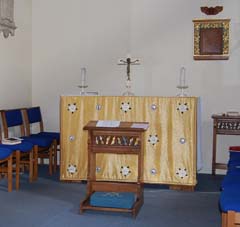 This chapel is dedicated to the Blessed Virgin Mary, mother of Jesus.
This chapel is dedicated to the Blessed Virgin Mary, mother of Jesus.
A light is kept burning in front of the aumbry (wall safe) behind the altar, indicating the presence of the Reserved Sacrament (consecrated bread and wine used for the communion of the sick).
The altar frontal incorporates symbols associated with St Mary the Virgin.
 The pulpit was installed during the rebuilding of 1889-90.
The pulpit was installed during the rebuilding of 1889-90.
It was given by Mr R W Henderson of Basing House, now part of the Local Authority Offices.
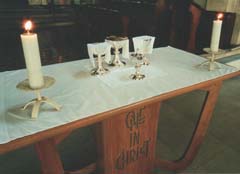 The chancel steps were extended in 2001 to form a nave platform which, together with the use of a moveable altar, enables the Priest to celebrate the Eucharist among the congregation, rather than at the distant High Altar.
The chancel steps were extended in 2001 to form a nave platform which, together with the use of a moveable altar, enables the Priest to celebrate the Eucharist among the congregation, rather than at the distant High Altar.
The moveable altar is dedicated as a symbol of united Anglican and Methodist worship in this church.
It also commemorates the long service of Graham D Martin FCSD as design consultant to St Mary’s.
The oak choir stalls date from the rebuilding of 1889-90. They were given in memory of the Revd A H Barker, Vicar 1853-84.
 Sir Thomas Fotherley, a Privy Counsellor to Prince Charles, later Charles II, and other members of his family purchased the lordship of the Manor of Rickmansworth in 1632, and died in 1649.
Sir Thomas Fotherley, a Privy Counsellor to Prince Charles, later Charles II, and other members of his family purchased the lordship of the Manor of Rickmansworth in 1632, and died in 1649.
The monument is by William Wood the Elder (c 1634-1731) a notable sculptor of the period. It probably dates from 1691-1702.
 The modern windows in the sanctuary incorporate stained glass from the old Rickmansworth High Street Methodist Church.
The modern windows in the sanctuary incorporate stained glass from the old Rickmansworth High Street Methodist Church.
That on the north is the Methodist Youth Fellowship Window of 1955, depicting the Cross of Christ, a boy carrying the Torch of Life, a girl with the Book of Knowledge, and John Wesley riding his horse.
That on the south is the window of the Methodist Women’s Fellowship and shows the Nativity with emblems of the Methodist Church and its Home Missions Division.
 This commemorates a descendant of Mary Boleyn – Henry Cary, 2nd Earl of Monmouth – who owned Moor Park until 1652. He died in 1661 without male heirs.
This commemorates a descendant of Mary Boleyn – Henry Cary, 2nd Earl of Monmouth – who owned Moor Park until 1652. He died in 1661 without male heirs.
Originally his tomb stood in the centre of the chancel where he and members of his family were buried.
In 1803 it was dismantled and the black marble slab became the top of the High Altar.
At the beginning of the last century, the parts were reassembled and placed in their present position.
Memorials to his daughter Elizabeth Cary and his grandson James Hamilton are set in the floor at the back of the church.
 The curtain behind the altar conceals the remnant of an elaborate setting removed towards the end of the 1930s.
The curtain behind the altar conceals the remnant of an elaborate setting removed towards the end of the 1930s.
The white altar frontal remains throughout the year. The colour of the fall (cloth) placed over it varies according to the season—purple for Advent and Lent, gold for Christmas, Easter and some Saints Days, red for Palm Sunday, Pentecost, Christ the King and Commemoration of the Martyrs, and green for the rest of the year.
 This window depicts Christ hanging from the Tree of Life, conquering the serpent of Evil.
This window depicts Christ hanging from the Tree of Life, conquering the serpent of Evil.
Below him, from left to right, stand Longinus the Centurion, St Mary Magdalen, St Mary the Virgin, and St John.
Along the bottom of the window are the symbols of the Four Evangelists; at the top is a choir of angels.
The window was made by Morris & Company in 1896. It is a composite design, the principal elements being by Sir Edward Burne-Jones.
Click here for more information about the stained glass windows in St Mary’s.
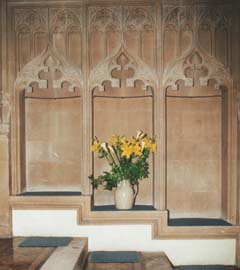 In the south wall of the Sanctuary there are a series of niches, included in the 1889-90 rebuilding in imitation of features common in mediaeval churches.
In the south wall of the Sanctuary there are a series of niches, included in the 1889-90 rebuilding in imitation of features common in mediaeval churches.
They are a piscina or sink for washing Communion vessels after use and three sedilia or stone seats for Priest, Deacon and Sub-Deacon for use during lengthy services.
None are commonly used for those purposes at present.
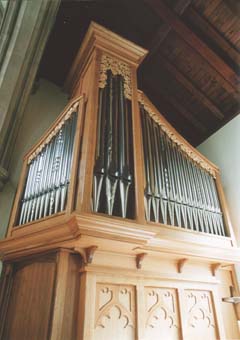 The organ was installed in 1951 by Messrs John Compton as a memorial to those of the parish who served in the 1939-45 war.
The organ was installed in 1951 by Messrs John Compton as a memorial to those of the parish who served in the 1939-45 war.
In 2001, the organ was substantially remodelled and a new great organ added which you can see behind the Resurrection Chapel.
The oak Lectern, from Penshurst Church in Kent, was given by the Revd A E Northey (Vicar 1884-98) and father of Lt Northey whom the Font commemorates.
 This chapel is for the commemoration of the faithful departed.
This chapel is for the commemoration of the faithful departed.
The Book of Commemoration is kept here.
 Many memorials have been re-sited on the walls or floor of the church and tower.
Many memorials have been re-sited on the walls or floor of the church and tower.
The Roll of Honour and Book of Remembrance of those killed in action are by the door into the Church Centre.
The town War Memorial is in the churchyard.


